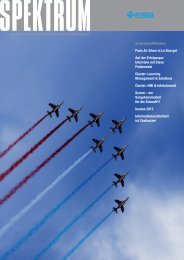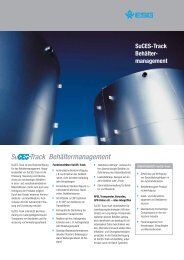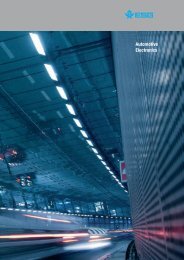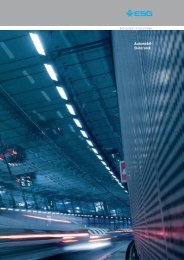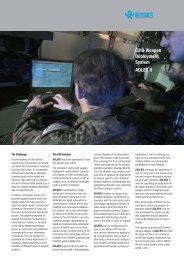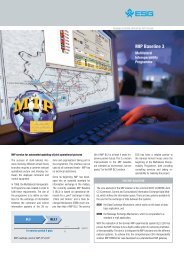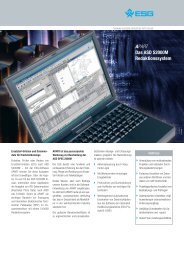Translation of TARANIS Interview with Heiko Seebode for ... - ESG
Translation of TARANIS Interview with Heiko Seebode for ... - ESG
Translation of TARANIS Interview with Heiko Seebode for ... - ESG
Create successful ePaper yourself
Turn your PDF publications into a flip-book with our unique Google optimized e-Paper software.
<strong>Translation</strong> <strong>of</strong> <strong>TARANIS</strong> <strong>Interview</strong> <strong>with</strong> <strong>Heiko</strong> <strong>Seebode</strong> <strong>for</strong> Spektrum I/2005<br />
“Synthesis <strong>of</strong> Experience and Innovation“<br />
<strong>ESG</strong> presents a new concept <strong>for</strong> a modular tactical C4I system, <strong>TARANIS</strong>.<br />
As a long-standing partner <strong>of</strong> the German Armed Forces, <strong>ESG</strong> has developed numerous C4I systems. Last year<br />
the company completed the development <strong>of</strong> the artillery computer network ADLER II; currently the next<br />
generation <strong>of</strong> the weapon deployment system <strong>for</strong> the mortar troops, DVA II, is being developed. Now <strong>ESG</strong> has<br />
presented a concept <strong>for</strong> a C4I system which can also be used by different troops: <strong>TARANIS</strong>. „Spektrum“ spoke<br />
<strong>with</strong> <strong>Heiko</strong> <strong>Seebode</strong>, head <strong>of</strong> „IT Systems <strong>for</strong> Operations“, about the background and advantages <strong>of</strong> this solution.<br />
What exactly is <strong>TARANIS</strong>?<br />
The name signifies a modular tactical C4I system which provides state-<strong>of</strong>-the-art DP support <strong>for</strong> all troop<br />
operations on the battlefield. It consists primarily <strong>of</strong> field-tested components <strong>for</strong> in<strong>for</strong>mation and resource<br />
management, fire control and ballistics. <strong>TARANIS</strong> integrates sensors and shooters from all troops and supports<br />
surveillance, target and engagement management. Modules <strong>for</strong> integrating different communication equipment<br />
complete the system functionality.<br />
<strong>ESG</strong> has been providing state-<strong>of</strong>-the-art C4I systems and solutions <strong>for</strong> many years. What new features does<br />
<strong>TARANIS</strong> <strong>of</strong>fer?<br />
<strong>TARANIS</strong>’ most significant features are its modularity and scaleability. These enable not just easy customisation<br />
<strong>of</strong> the system to the specific requirements <strong>of</strong> different troops, but also provide core functionality and <strong>of</strong>fer our<br />
customers the best possible investment protection through reusability. With these advantages we are also in an<br />
ideal position <strong>for</strong> entering the international market.<br />
<strong>TARANIS</strong> is based on the experience we gained during the lengthy development phase <strong>of</strong> projects such as<br />
ADLER and DVA. We see <strong>TARANIS</strong> as a synthesis <strong>of</strong> these experiences and our innovative solution approaches.<br />
In contrast to ADLER, <strong>TARANIS</strong> covers the requirements <strong>of</strong> different troops and links their sensors and weapon<br />
systems in an efficient network. Thus <strong>TARANIS</strong> supports the network-centric capabilities <strong>of</strong> the German Armed<br />
Forces and can be the functional complement to the command, control and in<strong>for</strong>mation system <strong>of</strong> the Army<br />
(FüInfoSys H) <strong>for</strong> the troops’ deployment needs.<br />
<strong>TARANIS</strong> <strong>Interview</strong> Spektrum I Page 1
If <strong>TARANIS</strong> is essentially based on ADLER, why has the name been changed?<br />
<strong>TARANIS</strong> is not ADLER III ! The system provides functionalities <strong>for</strong> different troops and addresses the current<br />
requirements <strong>for</strong> network-centric solutions and concepts arising from the trans<strong>for</strong>mation process.<br />
Previous approaches were generally focussed on the needs <strong>of</strong> the individual troops. ADLER was an ideal solution<br />
<strong>for</strong> this. Now, however, modular, highly networked solutions <strong>for</strong> the battlefield are necessary in order to meet the<br />
threat scenarios and organisatory requirements <strong>of</strong> armed <strong>for</strong>ces in the 21st century appropriately <strong>with</strong> DP<br />
support. We are following this paradigm shift <strong>with</strong> the new name.<br />
In 2005 we will further develop <strong>TARANIS</strong>, in particular in terms <strong>of</strong> efficient data exchange. We will thereby use<br />
synergies from different projects and integrate standardised components. With this procedure we guarantee our<br />
main customer, the German Armed Forces, not just investment protection but also sustainability.<br />
The USA are at the <strong>for</strong>efront in the area <strong>of</strong> networking on the battlefield...<br />
You are right. In the areas in which we in Europe are cautiously beginning to consider solution possibilities, the<br />
US <strong>for</strong>ces have already reached the implementation stage. A typical example is the further development over the<br />
last few years <strong>of</strong> AFATDS - previously a system solely <strong>for</strong> the artillery - into a tactical battle command system.<br />
The US Army and Marine Corps realised very quickly that in the age <strong>of</strong> Network Centric Warfare (NCW) it makes<br />
little sense to implement similar functions <strong>with</strong> different IT solutions. The sustainability <strong>of</strong> this comprehensive joint<br />
approach was verified sufficiently during the Operation Iraqi Freedom.<br />
Admittedly, the US Army und Marine Corps also invested a total <strong>of</strong> 270 million dollars in the implementation <strong>of</strong><br />
this system.<br />
Do you mean that the German Armed Forces would have to invest a similar amount in order to achieve<br />
comparable capabilities on the battlefield?<br />
<strong>ESG</strong> is a medium-sized company and thinks in different financial dimensions to the large defence companies in<br />
the USA. As partner <strong>of</strong> the German Armed Forces we have always made sure over the last 40 years that we<br />
develop not just technically high-quality but also cost-efficient solutions that are customised according to the real<br />
needs <strong>of</strong> the customer. We sum up this focus on process optimisation in the term „Operations Integration“.<br />
Since the contract <strong>for</strong> the command and control system <strong>of</strong> the German Army (FüInfoSys H) was closed at the end<br />
<strong>of</strong> 2004, few resources remain <strong>for</strong> the requirements <strong>of</strong> the troops <strong>for</strong> weapon deployment systems. With<br />
<strong>TARANIS</strong> we want to help make the most efficient use <strong>of</strong> these resources as possible.<br />
<strong>TARANIS</strong> <strong>Interview</strong> Spektrum I Page 2
Currently, <strong>for</strong> example, the project DVA II is benefiting from <strong>TARANIS</strong> concepts, as certain core modules, which<br />
were originally developed <strong>for</strong> ADLER, are reused and customised <strong>for</strong> the needs <strong>of</strong> the German mortar troops. We<br />
can definitely envisage further areas in which a similar approach – namely the adaptation <strong>of</strong> existing<br />
implementations – could be applied successfully.<br />
As you mentioned, the military environment is changing. What kind <strong>of</strong> new tasks will <strong>TARANIS</strong> have to master in<br />
the future?<br />
Through our participation and activities in the international interoperability programme ASCA (Artillery Systems<br />
Cooperation Activities) we are already able to support combined operations. For the future we have resolved to<br />
further expand our joint capabilities i.e. our interface to the Navy and Air Force, also to the Armed Forces support<br />
troops if required. Joint fires, in particular naval gunfire and close air support, are typical requirements that need<br />
DP support.<br />
With further technical development we want to expand our first PDA-based application modules and improve our<br />
capabilities <strong>for</strong> image data transmission <strong>with</strong>in the <strong>TARANIS</strong> network. A further topic <strong>for</strong> the near future that we<br />
are concentrating on is the harmonisation <strong>of</strong> <strong>TARANIS</strong> <strong>with</strong> the FüInfoSys H.<br />
I am convinced that, <strong>with</strong> <strong>TARANIS</strong>, we are ideally positioned <strong>for</strong> all these challenges and will make an effective<br />
contribution to the implementation <strong>of</strong> network-centric capabilities in the German Armed Forces.<br />
<strong>TARANIS</strong> <strong>Interview</strong> Spektrum I Page 3



